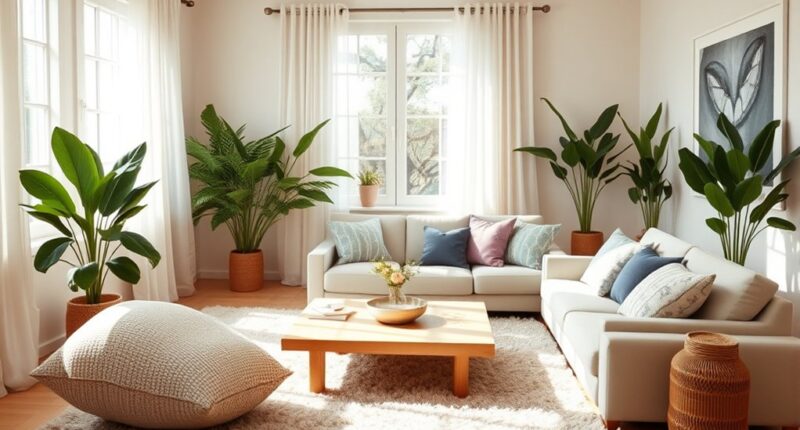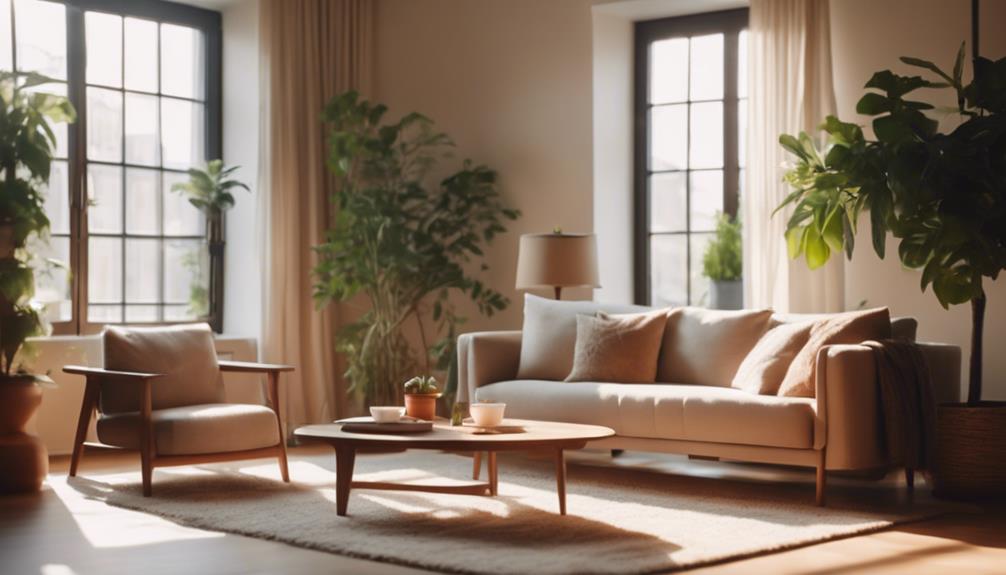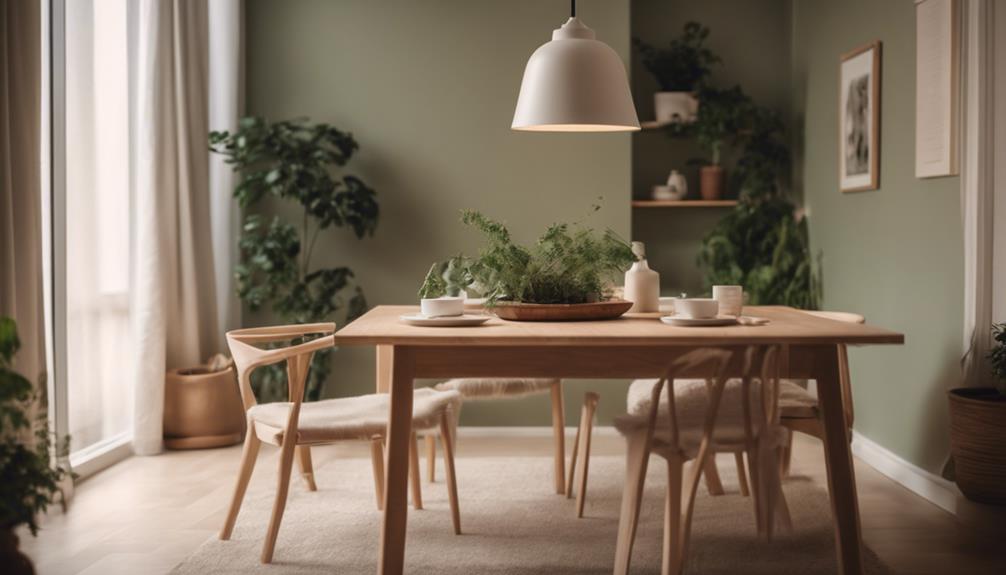Focusing on serotonin spaces instead of dopamine décor means creating environments that support your long-term mental health and mood stability. By incorporating natural light, calming colors, and mood-boosting plants, you can naturally elevate your serotonin levels, leading to sustained happiness and resilience. Unlike fleeting, attention-grabbing décor, serotonin-focused spaces promote emotional well-being over time. If you want to learn how to craft spaces that truly nourish your mind and mood, keep exploring the concept further.
Key Takeaways
- Prioritizing serotonin-boosting elements creates supportive environments that promote long-term mental well-being over fleeting dopamine hits.
- Incorporating natural light and greenery enhances mood stability and aligns with the body’s circadian rhythms.
- Designing spaces with calming textures and soothing colors fosters emotional resilience and reduces stress.
- AI security and environmental quality improvements ensure safe, healthy spaces that support mental health.
- Focus shifts from temporary visual pleasure to creating nurturing environments that sustain happiness and emotional balance.

Have you ever wondered how your environment influences your mood and mental health? It’s more important than you might think. Creating a space that nurtures your well-being isn’t just about aesthetics; it’s about fostering an atmosphere that boosts your serotonin levels naturally. Instead of focusing on dopamine-driven décor that offers fleeting satisfaction, more people are turning to serotonin spaces—settings designed to stabilize and elevate your mood over time. One of the key elements in these spaces is incorporating mood boosting plants. These plants aren’t just decorative—they actively improve air quality and bring a calming presence that encourages relaxation, helping you feel more grounded and content. Think of lush green foliage and vibrant blooms as natural mood enhancers that connect you to nature, which research shows can profoundly elevate serotonin production. Additionally, designing spaces with AI security principles in mind ensures your environment remains safe and supportive, further promoting mental well-being. Alongside mood boosting plants, natural light optimization plays an essential role. When you optimize your environment to maximize sunlight, you’re fundamentally inviting more of that necessary, mood-enhancing energy into your space. Natural light stimulates your body’s production of serotonin, the neurotransmitter tied to feelings of happiness and well-being. So, positioning your workspace or living area near windows, or using reflective surfaces to bounce light around, can make a noticeable difference. Even during overcast days, a well-lit space can help maintain your mood and mental clarity. This focus on natural light isn’t just about brightness; it’s about creating a rhythm that syncs with your circadian cycle, promoting better sleep and overall mental health. Incorporating mood-enhancing elements such as calming textures and soothing colors can further deepen the positive impact of your environment. Creating environments that include air quality improvements can significantly influence mental health by reducing pollutants that affect mood and cognition. In designing a serotonin space, you’re actively choosing to create an environment that supports your emotional health. It’s about making intentional choices, like selecting the right plants and maximizing natural light, to craft a sanctuary that encourages positivity and stability. When you surround yourself with mood boosting plants and optimize natural light, you’re not just decorating—you’re cultivating a space that nurtures your mind and body. This approach shifts the focus from short-term dopamine hits to long-term serotonin stability, helping you feel more balanced and resilient. Ultimately, your environment becomes a partner in your mental health journey, supporting steady moods, reducing stress, and fostering a sense of calm. By prioritizing these elements, you’re taking meaningful steps toward a happier, healthier space that genuinely works for you. Recognizing the importance of environmental design as a tool for mental health can empower you to make more mindful choices in your daily life.
Frequently Asked Questions
How Do Serotonin Spaces Differ From Traditional Wellness Environments?
Serotonin spaces differ from traditional wellness environments because they focus on enhancing neurotransmitter balance through calming, sensory stimulation. You’re encouraged to relax and connect with your surroundings, promoting feelings of happiness and well-being. Unlike dopamine-driven spaces that emphasize excitement, serotonin spaces create a soothing atmosphere that nurtures mental health. You’ll find these environments designed to help you unwind, recharge, and foster a sense of inner peace.
What Are Key Design Elements That Promote Serotonin Production?
Did you know that incorporating nature-inspired elements can boost serotonin levels by up to 20%? To promote serotonin production, focus on design elements like lush greenery, natural light, and calming color psychology. You should use soft, soothing colors such as blues and greens that evoke tranquility. Adding natural textures like wood or stone creates a grounding atmosphere. These features help foster a sense of well-being and elevate mood naturally.
Can Serotonin-Focused Décor Improve Mental Health Outcomes?
Focusing on serotonin-inspired décor can positively impact your mental health by promoting neurotransmitter balance. When you incorporate calming colors, natural elements, and cozy textures, you create an environment that supports mood enhancement techniques. These design choices can reduce stress and foster relaxation, contributing to improved mental well-being. Overall, serotonin-focused décor encourages a peaceful space that helps stabilize your mood and boost your overall mental health.
Are Serotonin Spaces Suitable for All Age Groups?
When considering serotonin spaces, you wonder if they’re suitable for all age groups. Absolutely, you should focus on age-appropriate design and accessibility considerations. Young children need cheerful, engaging environments, while seniors benefit from calming, accessible spaces. By tailoring serotonin spaces to suit different age needs, you create comfortable, inclusive environments that promote mental well-being for everyone, regardless of age.
How Can I Create a Serotonin Space in My Home?
To create a serotonin space in your home, focus on biophilic design elements that connect you with nature, like indoor plants or natural light. Incorporate sensory stimulation through soft textures, calming scents, and gentle sounds to boost your mood. Arrange cozy, inviting areas that encourage relaxation and mindfulness. By blending natural elements with thoughtful sensory touches, you’ll craft a space that promotes happiness and well-being, elevating your daily environment effortlessly.
Conclusion
So, next time you rethink your space, remember that serotonin spaces boost happiness and well-being. Studies show that environments designed to enhance serotonin levels can improve mood by up to 30%. By creating calming, nature-inspired areas, you can foster a sense of peace and contentment. Don’t underestimate the power of your surroundings—your space can truly influence your happiness, making serotonin-inspired décor the smarter choice for a more joyful life.









